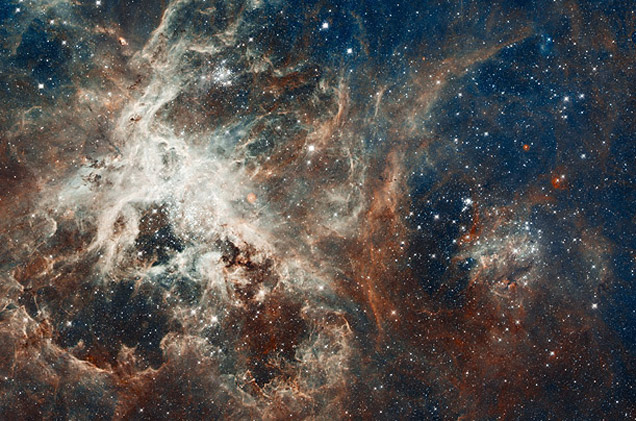 NASA:
NASA: The question lies on whether we are alone in the universe or not. NASA’s top scientist answered it could practically be “no”.
That’s a forgone conclusion. There are billions of stars in the universe and each star has a couple of planets or more orbiting around it. Several of those will definitely have earth-like atmosphere that will support life just as we know it. Even if they don’t, life would still exist which is totally different from ours.
“I believe we are going to have strong indications of life beyond Earth in the next decade and definitive evidence in the next 10 to 20 years,” stated Ellen Stofan on Tuesday , National Aeronautics and Space Administration chief scientist , during a public panel in Washington. “We know where to look, we know how to look, and in most cases we have the technology,”
“It’s definitely not an if, it’s a when.” Jeffery Newmark , an interim director of heliophysics at the agency , stated .
Yet it does not actually mean that scientist are up to finding aliens . “We are not talking about little green men,” Stofan explained . “We are talking about little microbes.”
We are on the cusp of discovering alien civilizations, NASA’s top scientists have said. They predict we’re one generation away from finding something in our Milky Way neighborhood, which is bustling with environments conducive to life.
Making their comments at a panel discussion Tuesday, the space scientists predict that the first discoveries will come within a decade. Chief scientist Ellen Stofan believes we’ll have “definitive evidence within 20 to 30 years,” as “in most cases we have the technology, and we’re on a path to implementing it. And so I think we’re definitely on the road.”
“I think we’re one generation away in our solar system, where it’s on an icy moon or on Mars, and one generation [away] on a planet around a nearby star,” former astronaut John Grunsfeld said at the session.
NASA has made huge strides in both spotting distant worlds and analyzing their chemical composition. Stofan said: “We know where to look.” Indeed, the Kepler mission has found no shortage of rocks that could support life, while icy moons in our own galaxy have long been suspected to hold incredible secrets beneath their own crust – among them Jupiter’s enigmatic moons – especially Europa, where a gargantuan body of water rages beneath the thin surface and water vapors are literally sprayed 200 km upward, giving clues to life-supporting minerals beneath. This while Ganymede is thought to have more water than all of Earth’s oceans combined.
The same can be said of Saturn’s satellite Enceladus.
Scientists found evidence to suggest that, like our more distant galactic neighbors, Mars also harbored entire oceans, the cracks and scars on its surface appearing to be made by raging water currents full of salt. All of this makes the Milky Way quite “a soggy place,” according to the director of NASA’s Astrophysics Division, Paul Hertz.
"We can see water in the interstellar clouds from which planetary systems and stellar systems form,” he says. “We can see water in the disks of debris that are going to become planetary systems around other stars, and we can even see comets being dissipated in other solar systems as [their] star evaporates them."
The Mars rover Curiosity, stationed on the Red Planet, continues to dazzle scientists with intriguing new finds. Just two weeks ago, it discovered organic molecules containing carbon and “fixed” nitrogen – elements central to all known life.
The Kepler mission’s overwhelming success has also been a godsend – its lens measuring the tiniest changes in the light intensity of a star, as a planet passes by it. With its robotic eye, it showed us that life and rocky worlds should be far more common in our galaxy than the likes of gassy Saturn and Jupiter.
Numerous advances in both technology and our ability to implement it mean we are also accelerating the pace. One US company has just been given a grant for its plasma rocket to reach Mars in just 39 days, while NASA itself is already hard at work on developing a new Mars lander that resembles a saucer and promises to make it possible to “safely land heavier spacecraft” on alien planets.
Humanity is facing two separate challenges in space: one is finding signs of intelligent life, the other is identifying potentially habitable environments. While one may rush to tie the two together, the latter is a considerably easier proposition to make.
Stofan is all but certain the manned mission to Mars will emerge with spectacular discoveries: "I'm a field geologist; I go out and break open rocks and look for fossils," she said.
"Those are hard to find. So I have a bias that it's eventually going to take humans on the surface of Mars — field geologists, astrobiologists, chemists — actually out there looking for that good evidence of life that we can bring back to Earth for all the scientists to argue about."
Europa will see us much sooner than that. As soon as 2022, our $2.1 billion will get to work on probing the mysteries of its oceans. And then there are the water vapors, spotted in the region next to the southern pole.
These discoveries are accompanied by huge strides in lens technologies NASA says will be central to finding alien life within two deacdes. Already there are several contenders for the next King of telescopes, their tech specs threatening to leave the famed Hubble far behind; among them the James Webb Space Telescope (JWST), which cost the space agency a fat $8.8 billion.
The technology onboard is strong enough to peer at distant ‘super-Earths’ and analyze the possible chemical composition of those worlds, the gasses they spew out being strong indicators of life.
For direct signs, however, we still need to take good old photos of the rocks, according to Hertz. That is why NASA is hard at work on the next generation of telescopes – one that will feature a coronograph.
The device is invaluable for blocking out the glare of the host stars of the exoplanets, giving us a clear view of the celestial bodies. It’s set to launch sometime in the mid-2020s.
 NASA: The question lies on whether we are alone in the universe or not. NASA’s top scientist answered it could practically be “no”.
NASA: The question lies on whether we are alone in the universe or not. NASA’s top scientist answered it could practically be “no”.